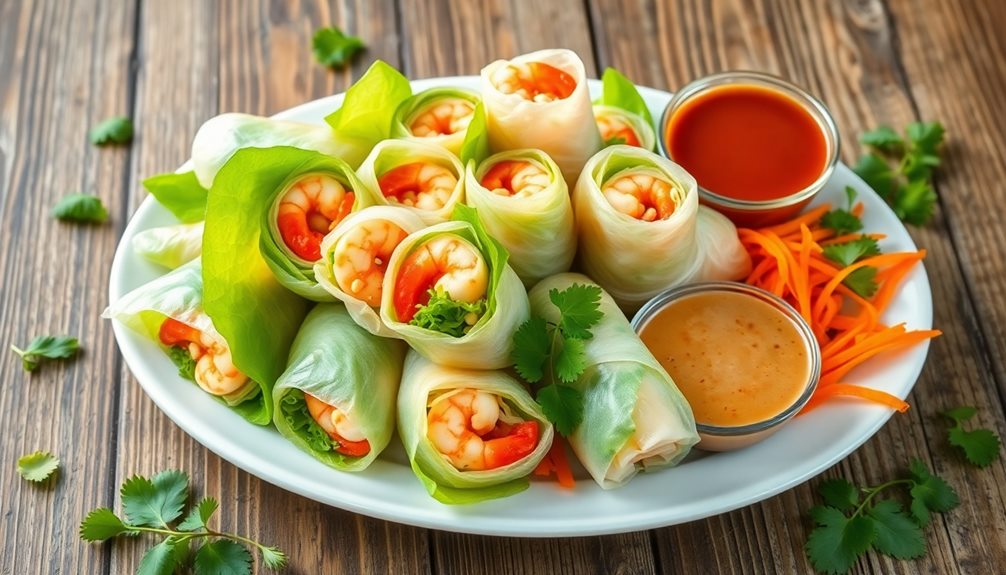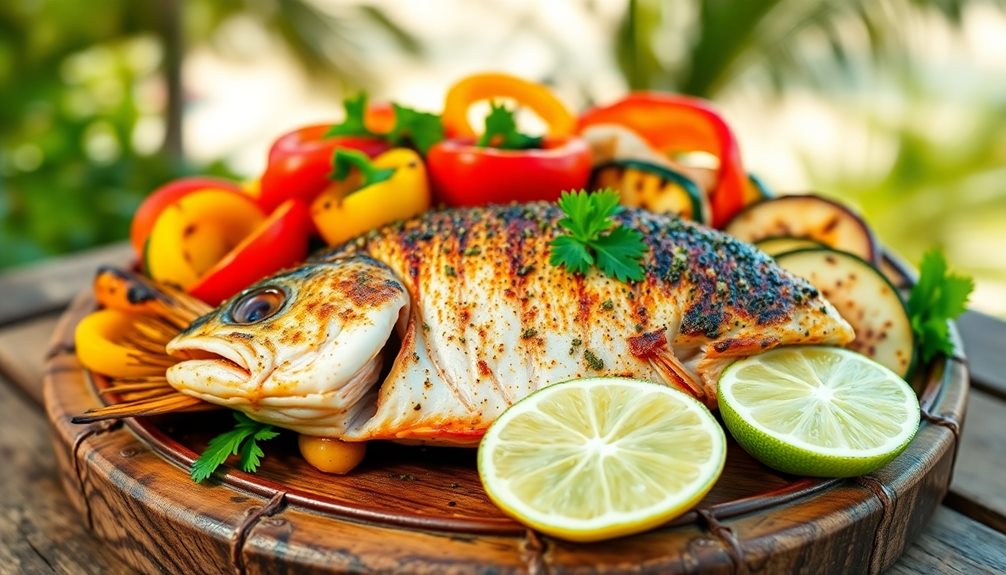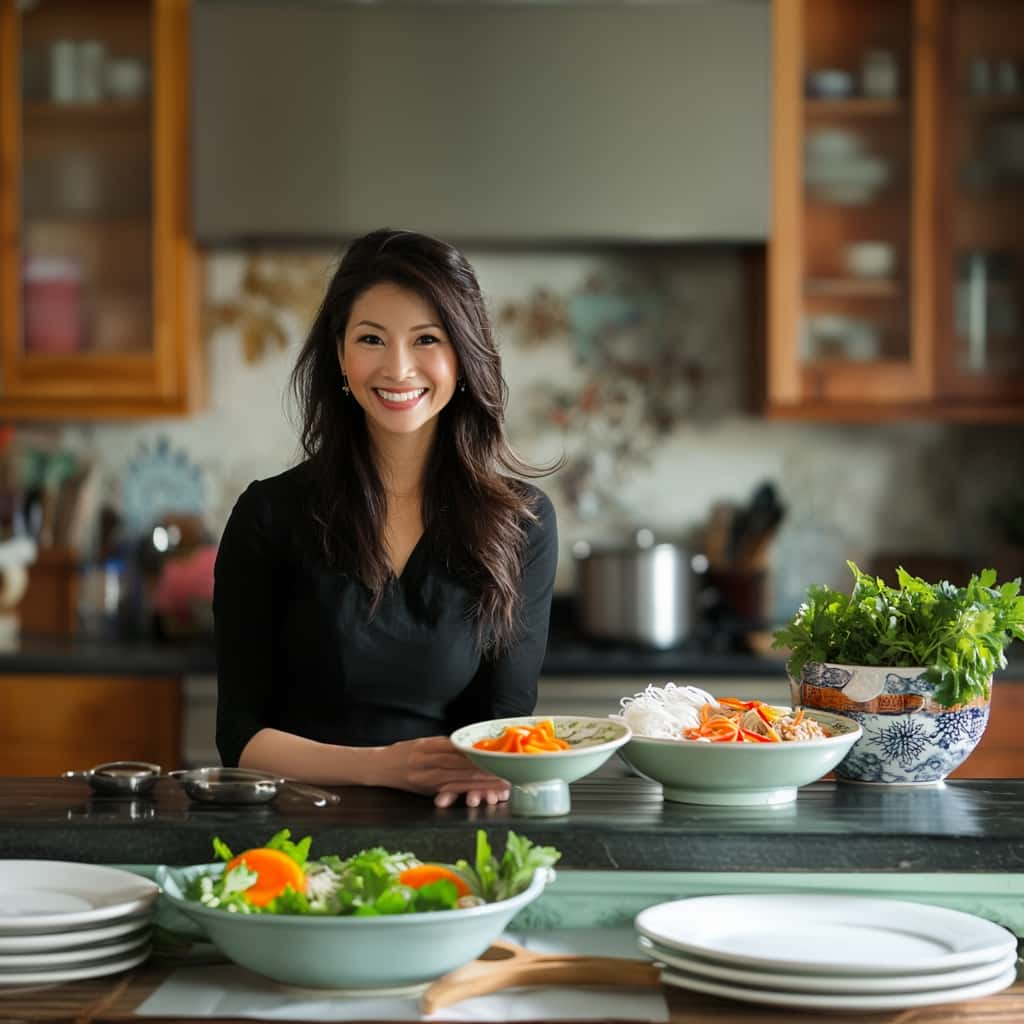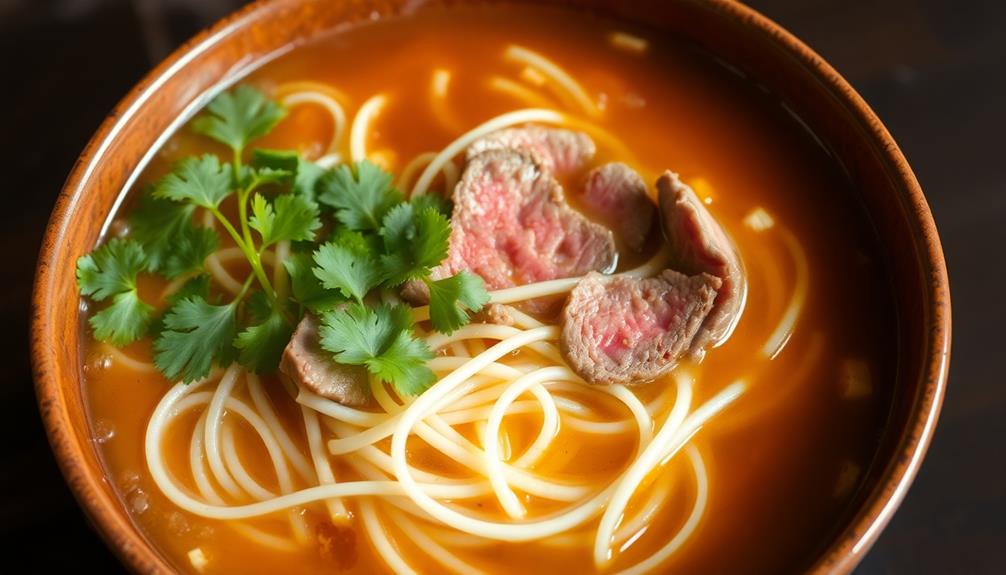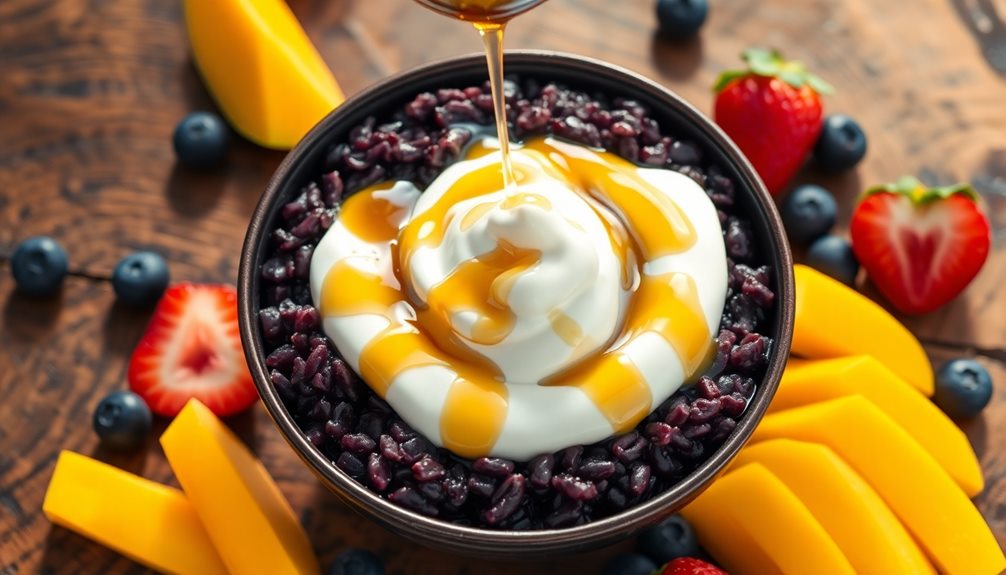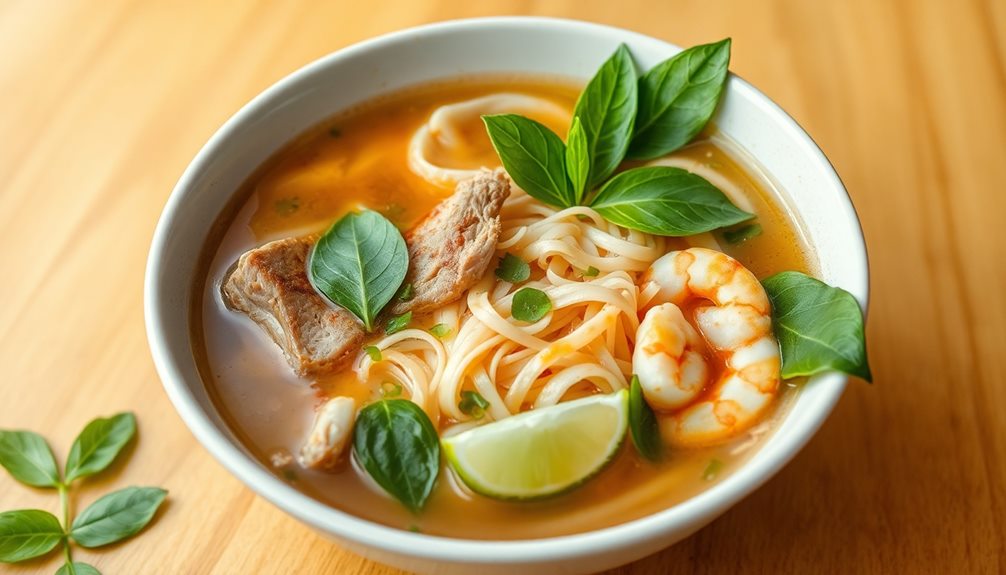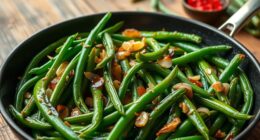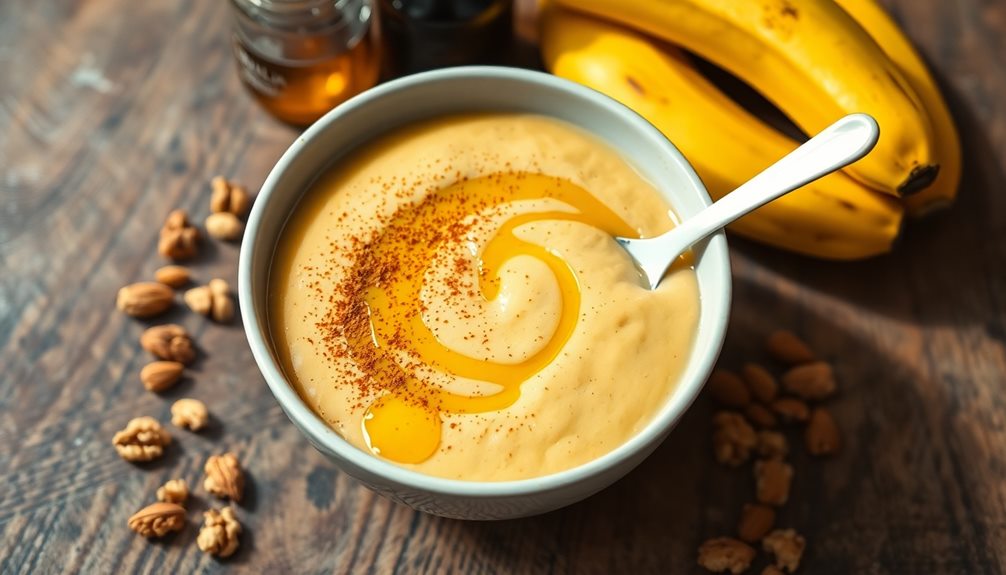Bò Bía rolls are a yummy Vietnamese delight packed with Chinese sausage, succulent shrimp, and fresh veggies! These colorful rolls are fun to make and perfect for sharing with family and friends. You start by soaking rice paper in warm water until it's soft. Then, you fill it with the sausage, shrimp, and your choice of crunchy vegetables. Roll it up tightly and fry until golden brown for a crispy finish. Don't forget to whip up a sweet and spicy dipping sauce! With their bold flavors and vibrant colors, you'll love every bite, and there's so much more to discover!
Key Takeaways
- Bò bía rolls are Vietnamese spring rolls typically filled with Chinese sausage, shrimp, and a variety of fresh vegetables.
- The rice paper is soaked briefly in warm water to become pliable before filling and rolling.
- Dipping sauce, usually sweet and spicy, enhances the flavor of these delectable rolls.
- Chilling the rolls for 30 minutes before serving improves their texture and presentation.
- Bò bía rolls are a popular communal dish, perfect for celebrations and sharing with friends and family.
History
Vietnamese spring rolls, known as "gỏi cuốn," have a rich history that dates back centuries. These delicious treats originated in Vietnam, where families and friends gather to enjoy them together. The rolls became popular because they're fresh, colorful, and packed with yummy ingredients. You might find shrimp, pork, or even tofu wrapped in rice paper, along with crunchy veggies and fragrant herbs. They are typically served with a tangy dipping sauce that perfectly complements their vibrant flavors. While enjoying spring rolls, many also pair them with other traditional Vietnamese dishes, such as a hearty Vietnamese beef hot pot recipe, making for a truly communal and comforting meal. This combination highlights the diverse and delectable cuisine that Vietnam has to offer.
As you dig deeper into their history, you'll discover that they reflect the spirit of Vietnamese culture. People often make spring rolls for special occasions, like Tet, the Vietnamese New Year. It's a time for families to come together, share stories, and celebrate traditions. The art of wrapping spring rolls is even passed down through generations, making it a cherished family activity.
You might also find that these rolls aren't just a tasty snack; they tell a story about connection and sharing. Whether you're enjoying them at a street vendor or making them at home, each bite brings a taste of Vietnam's rich culinary heritage.
Cooking Steps
To make delicious spring rolls, you'll want to gather all your ingredients and prep them before you start cooking.
Begin by chopping up your veggies—carrots, cucumbers, and lettuce—into thin strips. Don't forget to slice your Chinese sausage too! It adds a lovely flavor.
Next, fill a large bowl with warm water. Dip one rice paper wrapper into the water for about 10 seconds until it's soft and pliable. Carefully lay it on a clean surface.
Now, it's time to assemble! Place a small handful of veggies and a few slices of sausage in the center of the wrapper.
Fold the sides over the filling, then roll it up tightly, like wrapping a present. Keep going until you've made as many spring rolls as you can!
If you want, you can make a dipping sauce by mixing soy sauce, lime juice, and a little chili for some kick.
Once everything's ready, enjoy your homemade spring rolls with friends or family. They're perfect for sharing and will surely impress everyone with your cooking skills!
Happy rolling!
Step 1. Prepare the Rice Paper
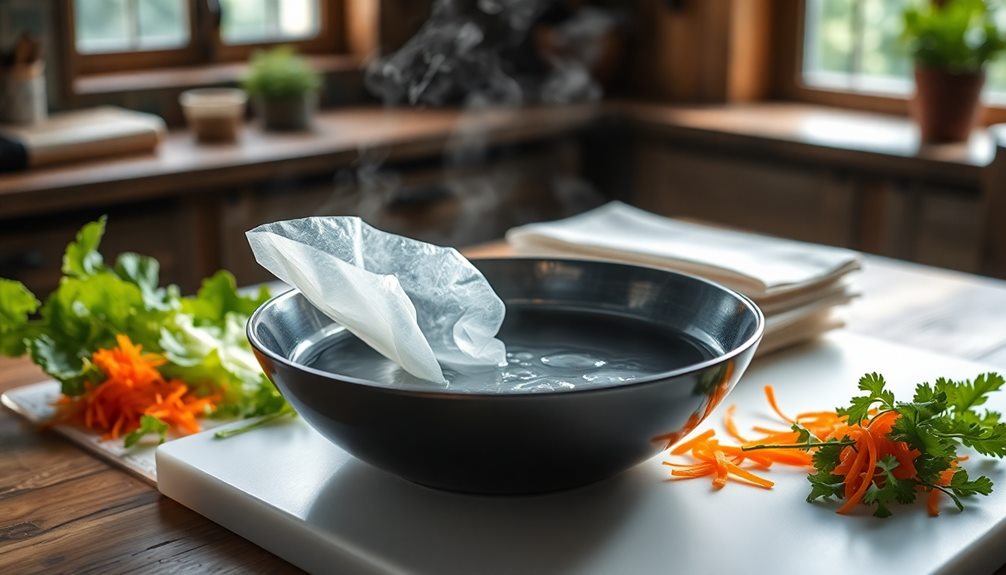
When preparing rice paper for spring rolls, you'll want to work with care to ensure a perfect texture. First, gather all your supplies, including a clean workspace and a flat plate or cutting board. It's important to have everything ready, so you can focus on the rice paper.
Next, take a sheet of rice paper and lay it flat on your plate. You'll notice it's hard and stiff right now, but don't worry! The magic happens when you start to soften it. Make sure to keep a bowl of warm water nearby. The water should be warm but not too hot, as you don't want to burn your fingers.
With both hands, gently dip the rice paper into the warm water. Count to about five or six, then carefully lift it out. The rice paper should feel soft but not mushy.
Place it back on your plate and let it rest for a moment. This is where the fun begins! Once you've prepared the rice paper, you'll be ready to fill it with all those delicious ingredients for your spring rolls. Enjoy the process!
Step 2. Soak Rice Paper Sheets
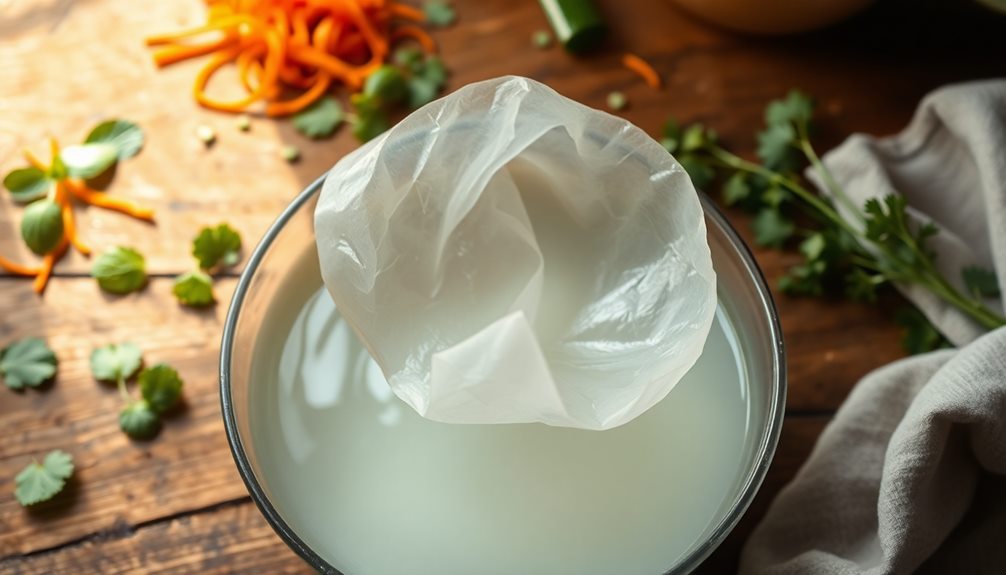
Soaking rice paper sheets is crucial for achieving the right texture in your spring rolls. If you skip this step, your rolls might end up tough and hard to chew!
First, grab a shallow dish or a big plate and fill it with warm water. The water should be warm but not boiling; you want it just right!
Now, take one rice paper sheet and gently place it in the water. Let it soak for about 10 to 15 seconds. You'll notice it starting to soften and become pliable. Don't rush this part—if you take it out too soon, it'll be too stiff to work with.
After it's soaked, carefully lift the sheet out of the water and let any excess water drip off.
Place the soaked rice paper on a clean, flat surface, like a cutting board or a clean kitchen towel. Make sure it's nice and smooth, so you have a perfect canvas for your filling later.
Repeat this process with the remaining sheets. And there you have it—your rice paper sheets are now ready for the next exciting step in making delicious spring rolls! Enjoy!
Step 3. Fill With Sausage Mixture
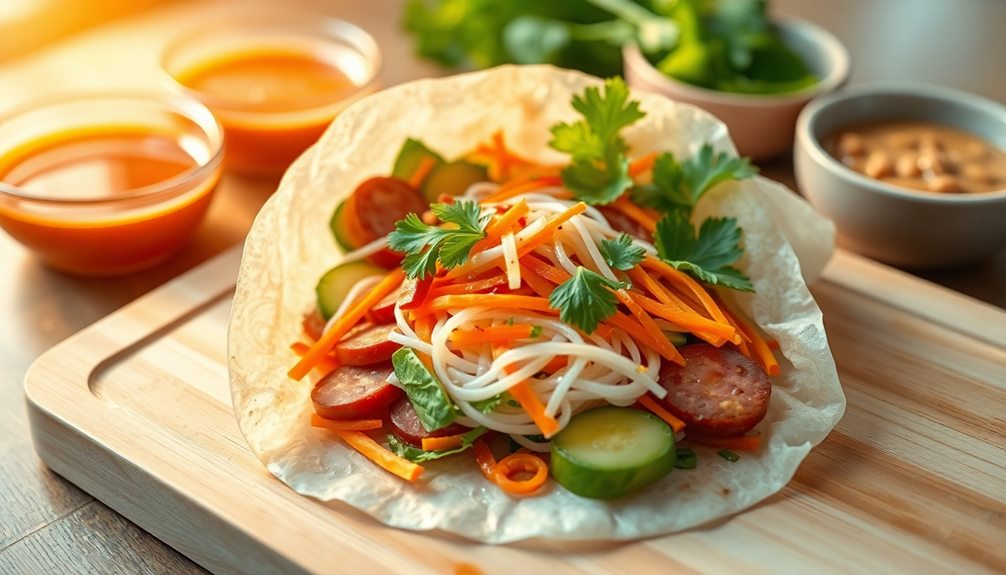
With your rice paper sheets ready, it's time to fill them with a savory sausage mixture that will elevate your spring rolls.
Start by taking a spoonful of the sausage mixture you prepared earlier. Place it near the center of the rice paper, but be sure to leave some space at the edges. You don't want to overfill, or your rolls might burst!
Next, sprinkle in some fresh herbs like mint or cilantro to add a pop of flavor. You can also add a few crunchy vegetables like shredded carrots or cucumbers for extra texture.
Once you've got your filling just right, it's time to fold. Carefully fold the bottom of the rice paper over the filling. Then, tuck in the sides and roll it up tightly, making sure everything stays snug inside.
Step 4. Roll the Spring Rolls
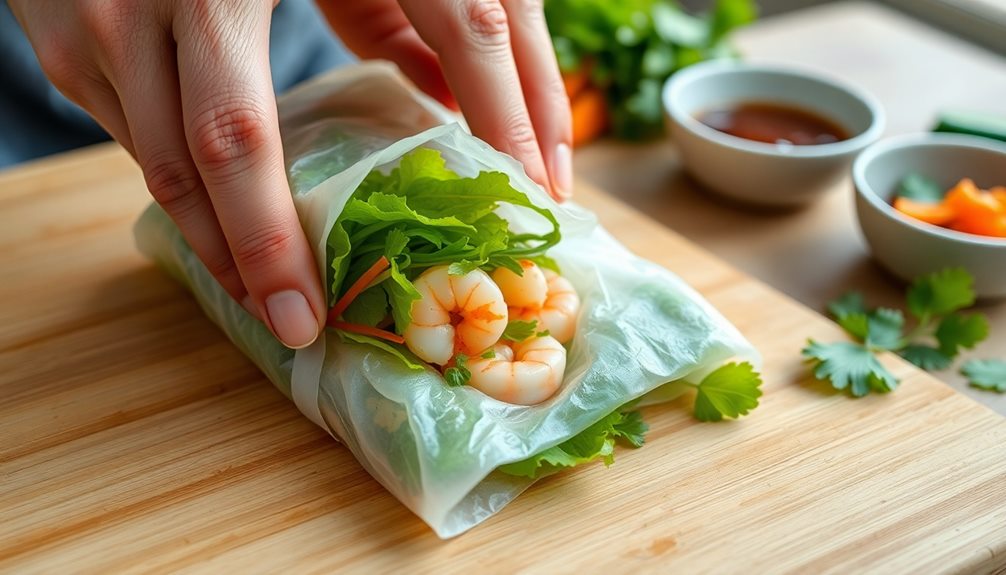
Now that you've filled your rice paper, it's time to roll the spring rolls up neatly. First, grab the edges of the rice paper closest to you and fold them over the filling. Make sure the filling is snug but not too tight. You don't want it to burst when you cook it later!
Next, fold the sides in toward the center. This helps keep everything inside and gives your rolls a nice shape.
Now, it's time to roll! Start from the edge where the filling is and roll away from you. Keep the roll tight, but don't squeeze too hard. You want a nice, even roll that looks great and holds all those yummy flavors inside.
When you reach the end of the rice paper, dab a little water on the edge to seal it. This will help it stick together so your spring rolls don't come apart.
Repeat this process for all your filling, and soon you'll have a plate full of deliciously rolled spring rolls. Isn't that exciting? You're just a few steps away from enjoying your tasty creation! Happy rolling!
Step 5. Fry Until Golden Brown
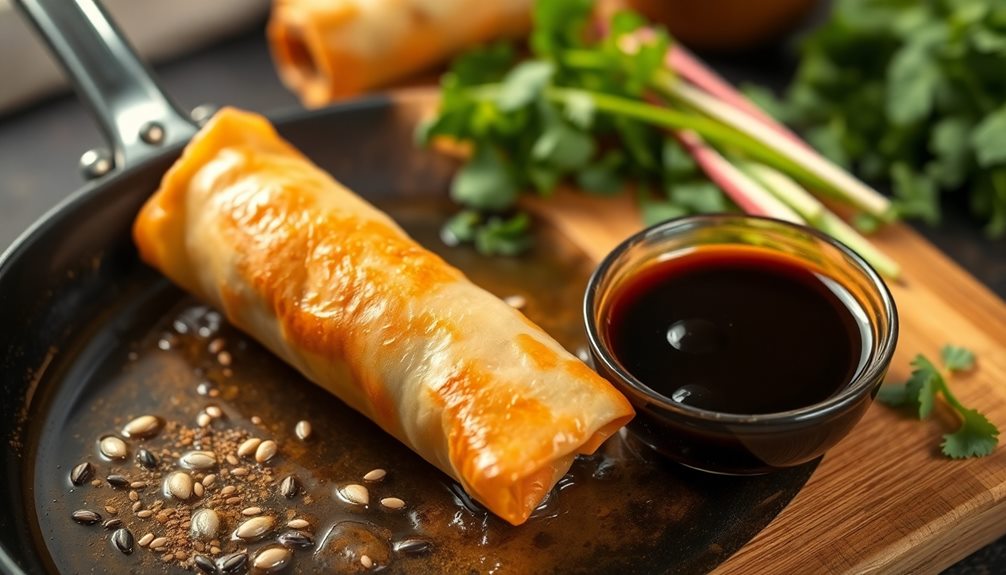
Once you've rolled your spring rolls, heat a generous amount of oil in a frying pan over medium-high heat. You want enough oil to cover the bottom of the pan, so your rolls can fry evenly.
When the oil shimmers, it's time to add your spring rolls! Gently place them in the hot oil, but be careful not to overcrowd the pan. This way, they can cook perfectly.
Let them fry for about 3 to 5 minutes on each side. You'll know they're ready to turn when they're a beautiful golden brown. Use tongs to flip them carefully, so they don't break apart. The sizzling sound means they're getting crispy and delicious.
Once both sides are golden, use a slotted spoon to lift the rolls out of the oil and let them drain on a paper towel. This helps soak up any extra oil, making them lighter to eat.
Now, you've got perfectly fried spring rolls! They're crispy, golden, and oh-so-yummy. Serve them warm with your favorite dipping sauce, and enjoy the tasty goodness you've created.
Happy cooking!
Final Thoughts
Why not take a moment to reflect on the delightful experience of making Vietnamese spring rolls? It's not just about the food; it's about the fun you have while preparing them!
Picture gathering fresh ingredients like crispy veggies, savory Chinese sausage, and those delicate rice papers. You get to roll them up, creating little bundles of joy. As you enjoy the process, you might think of the communal aspect of Italian meals, similar to sharing a traditional dish like Cacciucco, where everyone comes together to savor the flavors.
As you fry them until they're golden brown, your kitchen fills with mouthwatering aromas that make your tummy rumble.
And let's not forget the joy of sharing! Whether you're cooking alone or with family and friends, everyone can join in on the fun. You can dip those tasty rolls into sweet and spicy sauce, making every bite a burst of flavor.
Frequently Asked Questions
What Ingredients Are Essential for Bò Bía Rolls?
To make delicious spring rolls, you'll need rice paper, vermicelli noodles, fresh herbs like mint and cilantro, vegetables such as lettuce and carrots, and protein options like shrimp, tofu, or, in this case, Chinese sausage.
Can Bò Bía Rolls Be Made Vegetarian?
Yes, you can definitely make vegetarian versions of summer rolls! Substitute ingredients like Chinese sausage with tofu or mushrooms, and load them up with fresh vegetables and herbs for a delicious, satisfying alternative. Enjoy experimenting!
How Long Do Bò Bía Rolls Last in the Fridge?
Bò bía rolls can last about 3 to 5 days in the fridge when stored properly in an airtight container. Just make sure to check for any signs of spoilage before enjoying them.
What Dipping Sauce Pairs Well With Bò Bía Rolls?
When it comes to dipping sauces, you can't go wrong with hoisin sauce mixed with peanut butter for a creamy texture. You might also enjoy a spicy chili sauce for an extra kick to your rolls.
Are There Any Common Variations of Bò Bía Rolls?
When you explore spring roll variations, you'll find options like shrimp, tofu, or pork fillings. Some use rice paper, while others incorporate lettuce or herbs, enhancing flavor and texture for a delightful twist.
